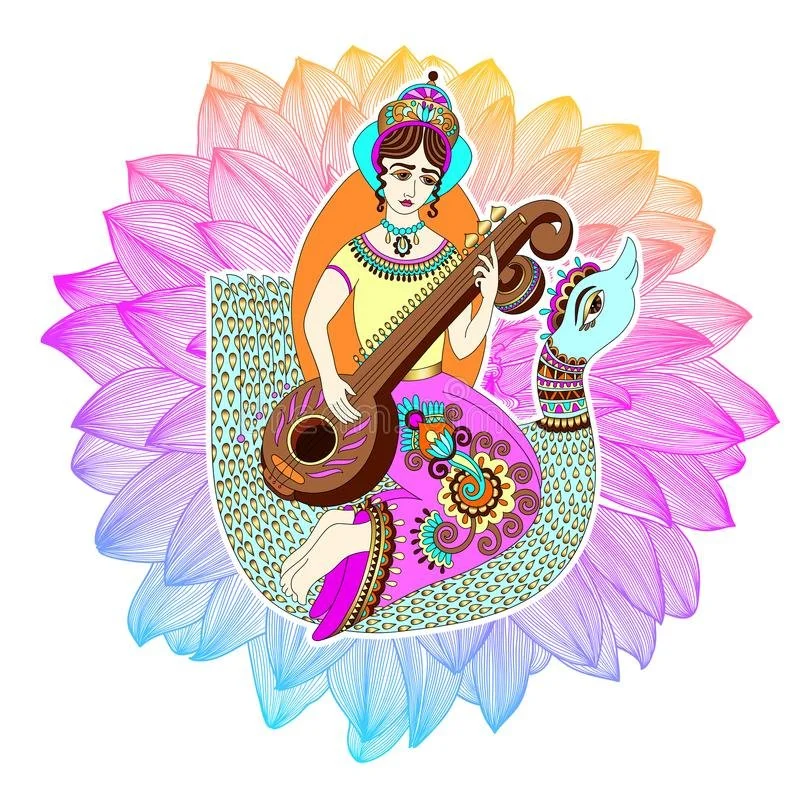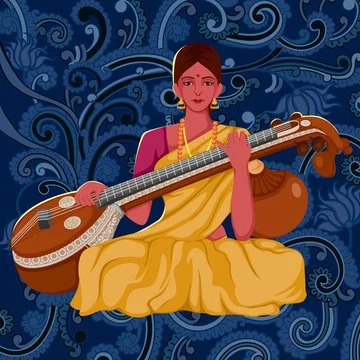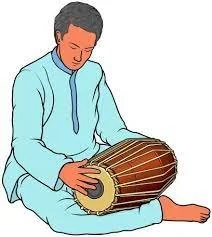

-
There are many different types of Carnatic instruments! Some include the Veena, Tabla, Mridangam, and the Flute. The Veena is a stringed instrument. It features four strings, the first being the highest pitch, with three talam strings. Talam strings set the tempo of the song. The scale of notes known as “Sa-Re-Ga-Ma-Pa-Da-Ni-Sa” repeats twice on each string. As you move up the string, each scale has a higher pitched scale. The tabla is a drum, the flute is a woodwind instrument, and the mridangam is apart of the percussion family.
-
A Raga is the melody or framework that an Indian song will follow. Much like a melodic scale, a Raga is a group of pitches. Indian music notes differ from the classic “do-re-mi” Western scale. Rather, Indian notes are defined as “Sa-Re-Ga-Ma-Pa-Da-Ni-Sa.” The last “Sa” is the highest note on the first scale. Carnatic music students start with learning Sarali Varisais, Keertanas, Geetams, Swarajatis, Varnams, and then songs. Sarali Varisais are your basic scale skills that get students accustomed to notes on the veena. Keertanas, Geetams, Swarajatis, and Varnams all build off of each other and combine talam, ragam, and Sarali Varisais skills to prepare you for songs. Swarajatis and Varnams are more complex “mini-songs,” to ensure students have a solid foundation before attempting to play songs- which are typically complex.
-
Carnatic music has a heavy influence in Indian Culture. It is typically performed at Hindu celebrations, Temples, and Hindu religious festivities. Carnatic music represents South Indian culture.

Veena
-
The Veena is the South Indian sister of the North Indian Sitar. The Veena was created in the district of Andhra Pradesh in the early 17th century. It is made completely of wood. Translations of the Rigveda and Atharvaveda, Hindu religious texts, into music have been performed on the veena. The veena is typically connected to the Hindu goddess Saraswathi, who represents arts and learning.
-
Goddess Saraswathi is most commonly depicted holding the Kacchapi Veena. The veena has been used as a form of meditative yoga for centuries in India. It is the main Carnatic instrument of India. The legendary veena musician, M.S Subbulakshmi, was awarded the Bharat Ratna, India’s highest civilian honor, for her contributions to Carnatic music.
Tabla
-
The Tabla is a pair of twin hand drums originating from India in the 18th century. It is played in both South Indian Carnatic music as well as North Indian Hindustani music. This instrument is extremely special because it can imitate many percussion instruments. The drums may vary slightly in terms of shape and size. Performers sit on the floor while playing the tabla. The Bayan is the left drum, made of copper, and the Dayan is the right drum, made of seesam wood.
-
The tabla can be played on its own or alongside the veena and a vocalist. However, it does accompany Indian classical dance forms such as Kathak and Bharatanatyam. Many regional vocalists and instrumentalists use the tabla as a way to add depth to their music. Some tabla greats include Ustad Allah Rakah and Zakir Hussain.
Mridangam
-
The Mridangam is a two headed drum that is held sideways, used commonly in South Indian Carnatic music. It is made of a piece of hollowed jackfruit cut one inch thick. The sides are covered with goatskin and tied with leather across the drum. This instrument has been around since 200 BCE! Unlike the tabla, which has two resonators, the mridangam has a single resonator.
-
Hindu myths state the mridangam was played by Lord Nandi (escort to Lord Shiva) during Lord Shiva’s sacred and auspicious Taandav dance. Notable players include T.K Murthy and Umayalpuram K. Sivaraman.


general music
questions!
Question #2
How does being involved in Carnatic music help connect you to Indian Culture?
Carnatic music is a central part of who I am. I’ve been playing the veena since I was seven and I distinctly remember my first performance at a Ganesh Chaturthi festival ( a celebration of the Hindu god Ganesha.) Despite my complete dedication to memorizing my sheet music, I was still trembling with fear backstage before the performance. But, after taking a few deep breaths I walked on stage and sat in front of the veena. I remember my fingers smoothly gliding over the frets, becoming engrossed in the beautiful melody of the music. Suddenly, all my worry and anxiety about performing disappeared. After this performance, I was enraptured by the Carnatic music culture.
Question #1
What part of the Carnatic music culture draws you in?
Question #3
If you did not participate in Carnatic music, do you feel that you would not have such strong ties to Indian Culture?
With Jayani Mannam, a Veena disciple of Shree Varshini
I love the way that playing the veena can be so experimental. Of course some songs are very rigid and don’t allow for artistic interpretation, but with others you can change the way sheet music is played to your own liking (as long as it fits the ragam and thalam correctly.) Not just the creativity that carnatic music allows, but also the connectivity between all the various indian instruments is so unique to Canrtaic music. Hearing a group of carnatic musicians playing the veena and tabla alongside a vocalist sounds so harmonious!
Being a Carnatic musician allows me to be very involved in the Indian community. Because a myriad of Hindu festivals feature Carnatic music as part of rituals and celebrations, many times I’ll attend these festivals to perform a few songs that are dedicated to the God being celebrated at that festival. There are also events such as CAMAGA (an Atlanta- based organization dedicated to the growth of Carnatic Music) that bring carnatic musicians together and allow me to truly be immersed in not just the veena, but all Carnatic instruments.
A while ago I learned a piece called “Mahaganapathim” and it’s dedicated to Lord Ganesha. I think learning religious songs like these, which are directly tied to aspects of Hinduism and Indian festivals, make me feel more connected with the culture as a whole. Of course sometimes I also learn fun songs from bollywood movies like Sagara Sangamam, which are cool to perform because people are like “oh wait! That’s from “so-and-so” movie.”
I definitely feel like I wouldn’t understand how intertwined Carnatic music and Indian culture are. Without being at the heart of Indian culture, in terms of attending festivals and rituals, I wouldn’t be so involved and probably wouldn’t be so eager to learn and understand more of my heritage. Carnatic music is a big part of what introduced me to Indian culture outside of just bollywood, food, and religion.
Through my music I really try to focus on understanding the Carnatic theory behind why a song is constructed a certain way. A difficult part of playing the veena is the fluidity, because lines can sound very separate and discordant if you’re not agile with the veena. Learning how to construct lines so that they build off one another, even if it minimizes the complexity of the song, is a method I use to help me learn new songs.

inspiration
inspiration
Going back to your own musical creations, are there specific artists that have inspired you?
VEENA
Veena Kappayer: The veena student of the famous composer Tyagaraga. He composed many famous songs such as Ninu Kori, Mammu Brochu, and Intha Chalamu Jesithe.
Asad Ali Khan: A recipient of the famous Padma Bushan award and deemed the best Hindustani rudra veena player.
I’m not sure if I had any specific artists that I looked up to when I first started playing the veena, but as I got older and more involved, I looked up to artists who were experimentally creative with the veena. I definitely respected the artists who had created my favorite songs, like Veena Kuppayyer (composer of Ninu Kori) or Asad Ali Khan (who won the coveted Padma Bhushan award.) I definitely enjoy experimenting with more basic songs, like varnams and keerthanams, and then using these techniques for the complicated songs I would learn. Notably, I remember learning a way to pull a fret in a Geetham and then using this technique in the song “Himagiri Tanye.”
Geetham: a rudimentary version of a varnam, usually used to practice basic skills


Do you experiment with creating your own songs, and if so, how do you use elements of Carnatic Music theory to make these songs both “technically correct,” and harmonious?
With Varshini Sudhakar, a Veena disciple of SMT. MALATHI KRISHNAMANI
Varshini Sudhakar | Veena Arangetram, Veena
What elements of Carnatic music do your favorite pieces include? What elements make learning a song easier for you? Are there specific techniques that you prefer using, and if so, why?
Varshini Sudhakar | Samajavaragamana, Veena
I like playing with elements of ragam and thalam to try and make songs both lyrically and harmoniously correct. It’s difficult sometimes because I want to change a song to set it into how I want to play, but sometimes it won’t fit that beat or style the song should be played in. Carnatic music theory has a lot of experimental areas, but when it comes to the notes in songs you play, the beats between the notes, or even whether or not to pluck a string at a given time, it’s very precise and you have to be meticulous with your understanding of theory in order to correctly play the song- especially when it’s not a veena performance, but a musical performance with veena, vocal, and tabla. I think a lot of what makes you a good veena player is not just being the best technical player, but also understanding why songs have been composed in a certain way, and what elements you can incorporate to really maximize the beauty of that song.
I love Carnatic music that incorporate pulling a fret back to imitate a note- there are eight basic frets on the veena (sa, re, ga, ma, pa, da, ni, sa.) Sometimes to make a song sound more cohesive, you can pull a note in a fret instead of having to slide up the veena to reach that given note. A common example of this would be pulling a “ma” in the “ga” fret. It sounds so cool when you do it correctly. I remember I really struggled with this technique when I first started. When song lines build off of each other, like with Gajananamutham, it makes it very easy for me to remember. During a performance, I worry I’ll forget one of my lines while playing. If song lines build off each other, it’s very easy for me to figure out what the next line should be (if I were to forget it.) Other specific techniques I prefer using include janta (which is plucking two notes at once) or pulling a note while sliding to give it more body. Like when I slide from “re” to “da", I’ll pull the “re” fret before sliding up to give a distinct shakiness- that’s like my signature playing style that I’ve developed.
WEB PAGE DESIGN BY JAYANI MANNAM



